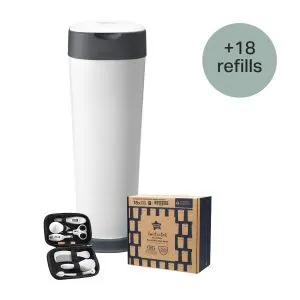
Ultimate XL Nappy Disposal Bundle with 18 Refills
Bundle & Save 40%
Subscription orders can be cancelled at anytime. Free delivery on all subsequent subscription orders. Find out more about subscriptions.
They’re easy and fuss free
Your products are automatically sent to you
You save up to 10% when you sign up for a subscription
You can cancel at any time
What is Cradle Cap & How to Treat It

If you are a new parent, you may have heard the term cradle cap, but perhaps you aren't quite sure what it means. Cradle cap (or infantile seborrheic dermatitis) is a common inflammatory skin condition that affects many infants within the first three months after birth.
It's characterised by scaly patches on their skin. While it may look alarming, rest assured that it's not contagious, isn't itchy or painful, and can be easily treated. In this blog, we'll explore the causes, symptoms, and treatments of cradle cap, so you can better understand it and care for your little one.
Cradle cap can look like white, yellow, or red patches of greasy, scaly, skin, or small, dry flakes like dandruff.
Although it usually appears on the scalp, cradle cap can also appear on a baby's:
If your baby gets cradle cap in their nappy area, it can help to keep the area as clean and dry as possible.
There are a few things that should be avoided when it comes to baby cradle cap, these include:
Cradle cap usually lasts for a few weeks to a few months, but it can vary from baby to baby. If you are concerned about your baby's cradle cap or if it seems to be getting worse, it's always best to seek advice from a healthcare professional.
It's important to note that while cradle cap is rarely cause for concern, as with any health or medical conditions, there does come a time when medical assistance might be needed.
You should seek medical assistance from your GP for your baby's cradle cap if:
If you notice any of these signs, it is best to consult with a healthcare professional as soon as possible. They will be able to determine the best course of action for your baby's specific situation. If the cradle cap is inflamed or infected, they may prescribe a specialist steroid cream to help treat it.
The best ways to prevent cradle cap are regularly washing your baby's hair with a specially designed baby shampoo, gently brushing their scalp, and making sure that all traces of shampoo, soap or cleansers are rinsed off your baby after bathtime.
No, the good news is that cradle cap isn't contagious. It can’t be caught or passed on from one baby to another.
Cradle cap typically goes away on its own within a few weeks or months, and usually resolves by four months of age. However, it's always better to be safe than sorry when it comes to your baby's health and trust your parenting instincts. If you have any concerns, it's best to consult with a healthcare professional to determine the best course of action.
Yes, you can use a soft brush on your baby’s scalp to gently loosen flakes.
You can take measures to gradually treat cradle cap at home, but you should never pick or scratch it. When it comes to cradle cap, it's best to be patient and remember that although it looks uncomfortable, it’s not likely to harm your baby.